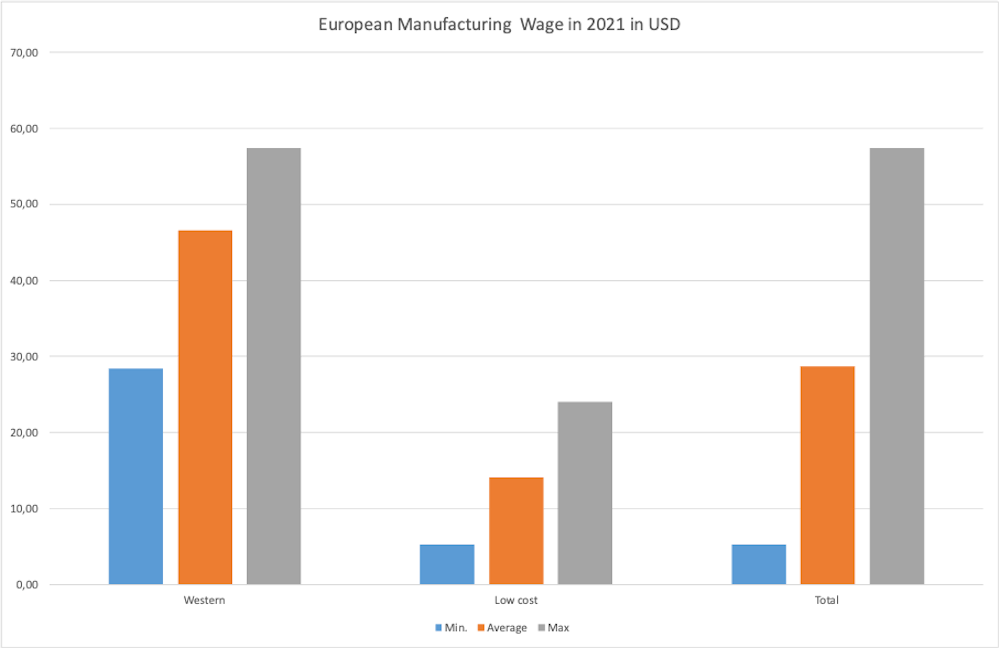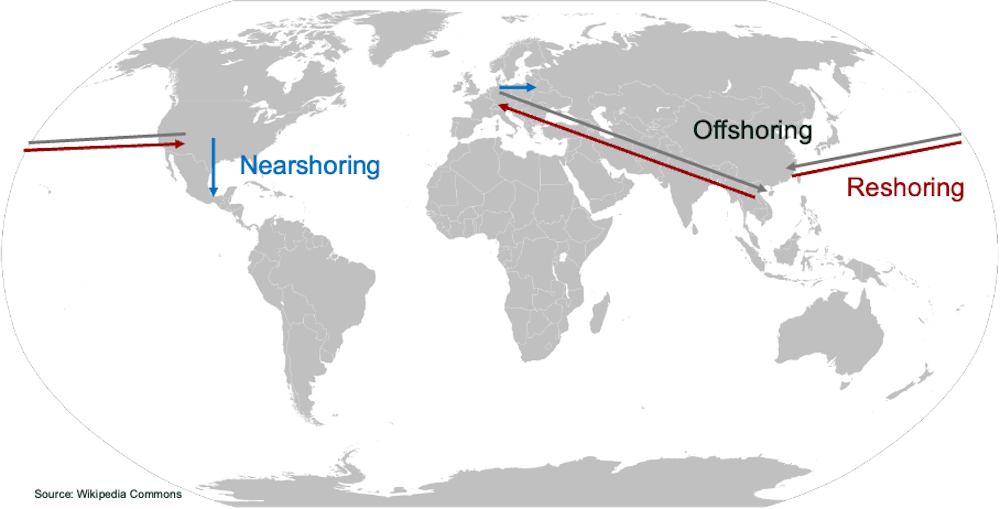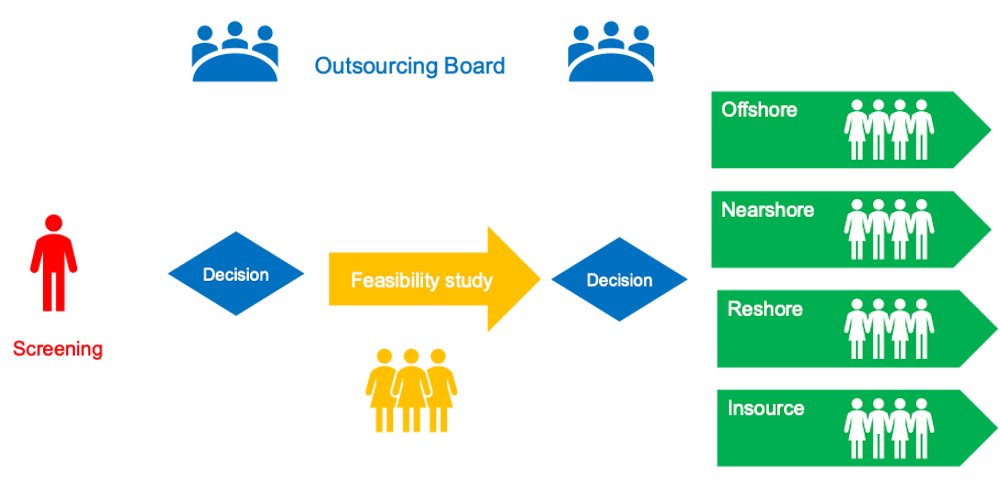Find the Right Shore for your Company
Find the Right Shore for your Company
Energy price increases, material shortage, limited labor availability, transport cost increases and bottlenecks require companies to rethink fundamentally the way how they do business. Many decisions in the past were directed at increasing efficiency internally or leveraging capable external suppliers with their product and process know how. During the pandemic, new criteria emerged for ensuring ongoing supply of products. Now there are many conflicting requirements and solution alternatives to deal with the new requirements, such as worker shortage or port closures. Limited labor availability at home forces companies to outsource further work. On the other hand, there is a lot of push to bring back work from previous offshoring work to avoid high transport costs, lockdowns or port closures and ensure a stable supply.
Many companies struggle with these decisions and this whitepaper will highlight possibilities how to find the right decision for your company, whether to outsource, insource or change the location of work. First, the different terms – outsourcing vs insourcing, offshoring, far-shoring, nearshoring, reshoring – are clarified and reasons for the different possible solutions will be described. Possible work content is discussed in the next chapter and finally, solutions to optimize the outsourcing processes are discussed. As a reader, you will be able to come to a better-informed decision and at the same time understand the key activities required to make outsourcing, reshoring, or insourcing work.
Outsourcing and Offshoring
Outsourcing is an abbreviation for outside resource using (Arnold, 2000). In this concept, a company is using outside resources, typically for processes. These processes include some business processes, but also manufacturing processes, such as electronic assembly (Lüthje, 2002).
The value chain movement has created a new basis for discussions in many companies in the 1990s(Barnes, 2001): Michael Porter initiated a key discussion in management circles: What are the core competencies, that a company needs to excel at? While selecting core competencies, other capabilities have been downgraded in their importance. Based on the economies of scope, many of these less important services have been moved to an external supplier, the concept of outsourcing was created and implemented in many companies.
At Henry Fords Rouge factory all process steps for one product were integrated in one factory and all required services have been provided by the company (III, 1981). The new norm has changed. Companies have replaced many internal service activities with outside service providers, outsourcing originally internal activities to an external partner. New companies focusing on service have emerged, calling themselves service providers. Providers focus on specific business services and optimize their processes and with specialization and higher business volume, can offer the same service at lower cost than a company. Service companies, such as logistics service providers (Lai, 2004) or security services, started and took over services from producing or retail companies.
During the same time, many trade borders disappeared and cross-regional supply intensified. For the US, the North American Free Trade Agreement (NAFTA) opened the borders to Mexico as a low-cost labor country. In Europe, with the fall of the iron curtain, many East European countries offered cheap labor and easy access with the expansion of the European Union. Many companies moved production from the US to Mexico.
On a global scale, the World Trade Organization (WTO) started in 1995 and eased the international trade for products and services. With China joining the World Trade Organization in 2001, the country’s low labor cost attracted many global companies to move production steps to China or source components from there.
This started the offshoring movement, moving component supply outside of high-wage-countries. In combination with the outsourcing movement, companies also moved production steps, such as electronic assembly, or other business process, such as help desks, to the low-cost countries, combining offshoring with outsourcing. The process was supported in electronic production with higher automation, as the quality of the electronic assembly could be achieved anywhere in the world due to the right machines.
The word offshoring has been synonymous with far-shoring (Colamatteo et al., 2021), as the main direction of offshoring had been to move production to Asian countries. Since the labor cost differential was very high, the transport costs were easily offset, and the companies saved a lot of money.

Figure (Lai, 2004): Comparison of labor cost per hour in Europe 2021 (Data source ILO)
Nearshoring
Many production shifts took also place from high wage countries in Western Europe to Eastern Europe countries. Even today, there is a significant cost difference between low-cost labor and Western Europe countries, the labor cost saving is 70% between average Western and average low-cost countries and can be up to 90%. For products with a high labor cost share, moving production made a lot of sense.
New Decisions in Changing Supply Chain Landscape
The labor cost difference led to many changes in the international supply chain. A lot of production of components or outsourced production steps a was moved to low-cost countries. Since the early days of transferring production, the wages in the previous low-cost countries have increased, and with the pandemic, many new risks and issues emerged, such as lock downs, port closures, or transport bottlenecks.
Many companies are reviewing their options:
Reviewing the options to buy complete components or to buy production services
Looking whether to in- or outsource production steps
Identifying the best locations for component production or production outsourcing.
With the recent political push to bring production back to the home country, the term of reshoring appeared. Reshoring describes that previously offshored activities are moved back to the country of origin.

Figure 2: Offshoring, reshoring, nearshoring
With offshoring production is moved to the global cheapest labor – mostly intercontinental. At the same time, within a continent, there are also low-cost countries. Moving production to these countries is called nearshoring.

Table 1: Nearshoring and offshoring options
Why Should you Reshore or Nearshore?
Many companies have seen many problems in the supply chain and are seeing additional risks with the non-planned lockdowns in China including port closures or long delays in ship transport from Asia due to port problems for loading and unloading. At the same time, high energy costs, transport cost increases and bottlenecks as well as the newly heightened awareness for decarbonization lead to a fundamental rethinking of the supply chain set-up. Also, changes in customs and duties can have an impact on the production decisions.
Politics has viewed moving labor back to a country as an important step to create wealth in a country. Buy American is one of the slogans that describes the political push for moving production locally. Additionally, new laws have been implemented to reduce the dependencies on other countries. The US Chips Act now limits the production of certain high-tech semiconductors in China, leading most likely to some changes in the electronics supply chain configuration.
The decision to reshore or nearshore is a decision with great impact. Production moves take time and effort and are therefore costly. Before embarking on a production relocation project, clearly define the objectives. Some objectives may be:
Does your company want to de-risk the supply chain?
Does your company want to reduce costs?
Does your company want to reduce reaction time?
Does your company want to reduce inventory?
Does your company want to reduce carbon emissions?
Ensure, that everyone involved in the decision is using the same objectives, as this can be used to create an evaluation scheme to compare pros and cons of the decision.
While labor cost will rise, most of the other costs will remain the same, except transport costs. A good first pass view of the costs is a comparison of how many labor minutes are in a sea container and comparing the costs for shipping the container to the labor savings. If the cost for transporting the goods exceed the labor cost savings, then the offshore production is not a good option.
Reaction time and availability of labor are other key considerations to decide between reshoring and nearshoring. If your company requires very fast delivery time – e.g., because of a high number of variants – than producing in the country with the highest number of sales is important, which is most likely your home country. If labor availability is limited and production cannot be automated, than moving production to a location with a large labor force may be critical.
Material costs may change as suppliers have different pricing strategies for different countries. At the same time, most materials are available at any location in the world.
What Should you Reshore or Nearshore?
Many companies are discussing the topic of reshoring or nearshoring. One of the questions that are asked many times, is which processes or parts should be reshored or nearshored?
The task can be broken down in two separate questions. The first question is looking at outsourced processes, the second question is looking at outsourced parts. For processes, keep a good overview, which processes have been outsourced to which location. Typically, a company does not keep a tab which tasks and how they were outsourced and for which tasks, an outsourcing was considered but not implemented. Based on such an inventory of processes, the company can systematically decide, whether the current outsourcing makes sense.
For the parts as the second question, the location of the suppliers can be analyzed in the same way. The focus is on suppliers outside of your home country. In parallel, you can identify parts with a high labor contents and processes, which are mainly driven by employees. For these items, it is necessary to check, whether longer lead-time will have an impact. The second major check is, if the processes can be digitalized or automated, avoiding high labor costs.
When answers for both questions are available, changes in labor costs, transport costs and any changes in custom duties can be identified per country. If there are significant changes – increases or decreases over 15% - it makes sense to review the situation based on the cost factors. Depending on the outcome, it will be valuable to review nearshoring/reshoring options for those parts and services, where the cost factors have changed significantly.
The automation/digitalization and the time factor will filter those items out, that need to be done locally. The longer the required reaction-time the easier it is to nearshore or with longer reaction-times candidates for offshoring the item.
Now, a check can be done for the remaining items and the costs for the different options – do internally vs outsource and if outsourcing: in-country vs nearshore vs offshore - determined. Based on the cost comparison and a strategic assessment, your company can decide which activities or parts should be outsourced and then decide on the right shore for these. If nearshoring is the best option, depending on the start situation, the company will need to reshore some of the activities.
How to make Reshoring or Nearshoring Happen?
There are several steps in making the rightshoring happen. The key process is to separate decision making from the necessary preparation work. Companies define an outsource governance board and define a decision framework in the governance body.

Figure 3: Decision process for rightshoring
Many companies implement a quarterly or semiannual review of the outsourcing options. In each review, a person is tasked to identify projects that are candidates for outsourcing. Based on the initial screening, the decision group identifies the project to follow. The companies commission a project team studying the feasibility of the outsourcing. The project team must get back in a defined time with the results of the feasibility study for the outsourcing board to come to a decision, whether to go forward with a project or not.
Once the results of the feasibility study have been presented, the outsourcing boards decides, whether to implement the outsourcing or not and which option to pursue. With a new project team the planned reshoring, nearshoring, offshoring or insourcing is implemented.
For nearshoring, the companies identify the necessary scope of the processes and define a new process. A supplier is selected and a plan for the transfer is developed. The transfer plan is executed by the project team. Additional inventory for the relocation time is build, if a production process is relocated. Employees from the new location are trained at the existing location and learn how to make the product. After the relocation, employees from the original work site are sent to the new location for further training.
Summary
The time for changes in the supply chain has come. The changed realities in the world will impact many decisions on global production and service footprint. While there are many reasons, many projects have failed in the past. Combining good decision making with a defined process will help your company to achieve higher success in your supply chain operations.
Bibliography
Arnold, U. (2000). New dimensions of outsourcing: A combination of transaction cost economics and the core competencies concept. European Journal of Purchasing & Supply Management, 6(1), 23–29. https://doi.org/10.1016/S0969-7012(99)00028-3
Barnes, D. (2001). Understanding Business: Processes. Psychology Press.
Colamatteo, A., Cassia, F., & Sansone, M. (2021). Near-shoring versus far-shoring: Effects on customer perceived quality and purchase intention. The TQM Journal, 34(5), 1416–1431. https://doi.org/10.1108/TQM-05-2021-0132
III, S. M. (1981). The Five Dollar Day: Labor Management and Social Control in the Ford Motor Company, 1908-1921. State University of New York Press.
Lai, K. (2004). Service capability and performance of logistics service providers. Transportation Research Part E: Logistics and Transportation Review, 40(5), 385–399. https://doi.org/10.1016/j.tre.2004.01.002
Lüthje, B. (2002). Electronics Contract Manufacturing: Global Production and the International Division of Labor in the Age of the Internet. Industry and Innovation, 9(3), 227–247. https://doi.org/10.1080/1366271022000034471